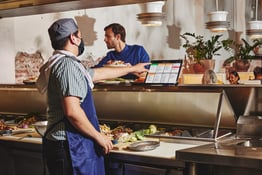Good news – the latest episode on our podcast So You Want to Run a Restaurant is ready to listen! This marks the second show of our three-part mini series focused on how tech can help solve some of the top problems facing restaurants.
This week, we’re talking robots and how automation is transforming restaurant kitchens with Anthony Tayoun, co-founder of Dexai Robotics. Dexai Robotics are the engineers behind Alfred, a robot sous chef capable of handling basic kitchen tasks, like prepping vegetables, scooping ice cream, and salad assembly.
With labor shortages at the forefront of many operators’ minds, Tayoun shares how automated solutions like Alfred have the potential to change the way restaurants think about staffing. Plus, we take a look at Alfred’s current capabilities to give insight into what robotic solutions look like in the industry today, along with what to expect in the future.
Read on for a snapshot of the conversation, or listen to the full episode on Google, Spotify, or Apple.
What can robotic solutions, like Alfred, actually do for a restaurant right now?
Restaurants are increasingly turning to robotics to ease staffing challenges. “It's really, in our opinion, the best solution out there to help restaurateurs tackle this labor shortage,” says Tayoun of automation solutions.
But how do they work, and what kinds of tasks can they actually accomplish? Right now, most robots are programmed to perform basic tasks, but with great precision. Alfred currently stars in assembly, capable of putting together, say, a salad or a burrito bowl, while logging each ingredient portion along the way.
“That's our first use case. From that we want to add on more things, from using a grill, a fryer, or even prep, so cutting, slicing, and dicing,” says Tayoun. “And all of that is possible with the same piece of hardware. Most of that stuff will be over-the-air software upgrades, so we're thinking of Alfred really as this tool that restaurants can use to automate a lot of their kitchen tasks.”
Tayoun says that while Alfred is currently capable of using utensils for basic tasks, some acts, like picking up a piece of chicken breast or a steak, remain challenging. These are the types of advancements that many robotics makers in the industry are working on now.
Will robots steal jobs?
While robots can alleviate short-staffed restaurants, most automation solution companies say they’re not designed to replace humans, but instead act as reliable assistants.
“The assembly task is something that very few people enjoy or like to do because it's the repetitive monotonous part of the job, right? People enjoy creating the recipes. They enjoy the hospitality aspect, but not so much the monotonous activity of assembling things and doing the same repetitive tasks over and over again,” says Tayoun. “There’s a role for a kitchen staff member to interact with the robot and have the robot be their own personal tool that they can use to become more effective and efficient at doing their job.”
How much training is required to operate Alfred? It's simpler than you would expect, says Tayoun.
“It's really similar to how you would interface with a tablet or a mobile phone,” he says. “Most of the time, you punch in what salad or what order you want the robot to do on a tablet, and then the robot will just go and do it.”
Some staff oversight is needed, however. For example, Alfred will communicate when it’s running out of ingredients, and a staff member will need to step in and refill empty containers. But in general, automated solutions are designed to free up staff to engage in more meaningful aspects of the job.
“The hospitality aspect of being in a restaurant is still central to the experience, and having that delivered by another human being is still central to that experience. I don't think that's ever going to go away, or at least not in the short term,” says Tayoun. “Similarly, on the creative side of food service, you know, coming up with new recipes, creating new food types, [that] will continue to be done by a person for the time being.”
How much does a robotic system cost?
Payment varies per company. Many charge a monthly subscription. Bear Robotics’ Servi, a robotic server, for example, costs $999 a month (which includes installation and support), or $12,000 a year, little more than half of what an average server would make per year, according to salary.com.
Dexai Robotics works off of a pay-as-you-go system, designed to match how much the robot’s being utilized. “In other words, the restaurant owner [is charged] with $1 or $2 for every bowl that the robot makes, and that would be the entire cost which includes servicing, maintenance installation, everything from from A to Z,” says Tayoun.
What does the future look like?
Automated solutions are increasingly becoming more complex. We can expect their capabilities to expand in the coming years.
“Eventually, we want the robot to do as many of the kitchen tasks as possible. And that means extending to different cuisines, different types of cooking, [and] different types of tools,” says Tayoun.
Dexai Robotics is currently working on adding a thermal camera to Alfred that would allow the robot to monitor food safety aspects like temperature and food storage settings. It can also help with allergy issues.
“From a contamination perspective, the computer vision system that we have in the robot is able to detect individual ingredients. So say you have a piece of nuts that falls into one of the salads – you can very easily alert the consumer and say, ‘Hey, this has nuts, [in case] you have a nut allergy,” says Tayoun.
Tayoun says the goal is to create technology that can be used not just in multiple restaurants, but eventually the home kitchen. “Our long term vision is to automate many kitchens in a commercial setting, but eventually we believe firmly that the solution will be capable and affordable enough that it can go in everyone's homes,” he says.
As companies scale, that’s when we can expect an affordable product to actually hit the market, says Tayoun. He also predicts automation to continue to expand in the delivery arena.
“It's a very natural place for automation to start,” he says. “[Automation] helps normalize costs quite a bit, [and] it helps reduce a lot of error rates that you see a lot in delivery.”
For more on automated solutions and Dexai Robotics, like how they’re training Alfred using artificial intelligence, and what the customer response has been like so far, listen to the full episode on Google, Spotify, or Apple.





